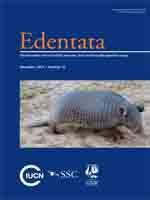WHERE'S THE SLOW? THE SLOTH ACTION PLAN NEEDS YOUR SUPPORT
The IUCN/SSC Anteater, Sloth and Armadillo Specialist Group (ASASG) has recently started developing an Action Plan for sloths. This ambitious project will include a range-wide status review, realistic and traceable objectives, and detailed actions that will help saving these fascinating animals from extinction.
We are now in the process of generating detailed maps of the geographical distribution of all sloth species. This represents very important information to, among others, properly assess differences between their historical and current range, identify isolated populations and suitable habitats, and determine potential re introduction sites.
To achieve this goal, the ASASG needs your help and calls for contributions on both historical and recent, accurate sloth records.
We would be very thankful if you could send us geographical data of your published or unpublished sloth sightings to <action_plan@xenarthrans.org>. Data should contain species name, detailed locality description, and date of sightings. In case you have georeferenced data, we would appreciate if you could send us the geographic coordinates and datum. Any additional information you would like to provide is welcome.
The ASASG appreciates your help and certifies that all contributions will be cited and acknowledged in the Sloth Action Plan. If you are willing to contribute to the Sloth Action Plan or would like to know more about this project, please email us at <action_plan@xenarthrans.org>. You are also very welcome to download the project description from the News section of our website < http://www.xenarthrans.org>. Thank you!
CALL FOR HELP: FECAL SAMPLES FROM XENARTHRAN SPECIES
I am starting a collaborative project with Pr. Hendrik Poinar (McMaster Ancient DNA Centre, McMaster University, Hamilton, Ontario, Canada; < http://socserv.mcmaster.ca/adna/team-members/hendrik-poinar/>) and Dr. Rob Knight (University of Colorado at Boulder, Boulder, Colorado, USA; < http://chem.colorado.edu/knightgroup/>) aiming at studying the evolution of the gut microbiome in xenarthrans.
We are currently searching for xenarthran fecal samples collected either from zoo animals or from wild individuals in the field in order to sequence the associated gut microorganisms.
Liquid Nitrogen preserved samples would be ideal for this study but lyophilized or dehydrated feces could also potentially work well.
We would be delighted to hear from anyone who could help us accessing to such samples and we are happy to compensate for any expenses involved.
Thanks in advance for your help.
Frédéric Delsuc, Institut des Sciences de l'Evolution — UMR5554-CNRS-IRD, Case Courier 64 - Université Montpellier II, Place Eugène Bataillon, 34095 Montpellier Cedex 05, France. Tel: (+33) 4 67 14 39 64, E-mail: Frederic.Delsuc@univ-montp2.fr, Website: < http://fdelsuc.perso.neuf.fr>
HANDBOOK OF THE MAMMALS OF PARAGUAY VOLUME 2: XENARTHRA
Contributions and editors requested
The Handbook of the Mammals of Paraguay project is a free, online, downloadable Handbook produced by FAUNA Paraguay (< http://www.faunaparaguay.com>). Complete handbook accounts for Volume 2: Xenarthra are now available online at < http://www.faunaparaguay.com/mammhb2.html>. Each handbook account provides a thorough review of the published literature for each of the species occurring in Paraguay — 2 species of Myrmecophagidae and 12 species of Dasypodidae — and is updated regularly as new material becomes available. The authors are seeking expert reviewers for the species accounts and/or assistance with the identification and provision of relevant bibliographical references that deal with any species occurring in Paraguay and which have not already been referenced in the bibliographical sections of each species account. Of particular interest are masters and PhD theses, older literature (pre 1990) and publications in local, obscure, foreign language or discontinued journals that are not widely available. The authors also will gratefully receive pdfs of new publications in order to keep the contents as up-to-date as possible. All contributions are welcomed and acknowledged. Please contact the authors directly at <faunaparaguay@gmail.com>. Thanks in advance.





